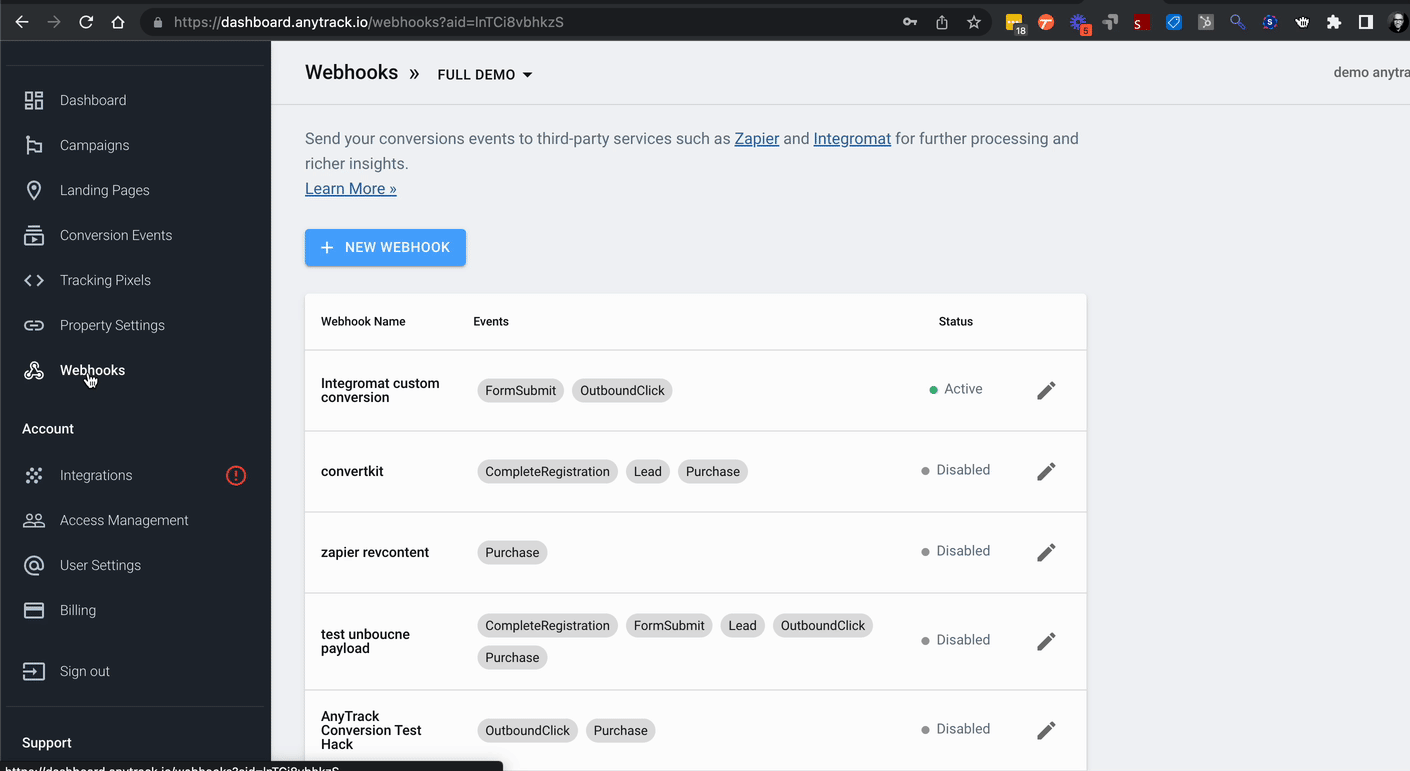Webhooks
Discover how to set up incoming and outgoing webhooks in AnyTrack to track events, automate conversions, and connect with thousands of apps via Zapier, Make, and more.
Webhooks are instant notifications sent by an application to a unique target URL. Generally, the target URL enables the server to process the notification content.
With AnyTrack, webhooks are used to send and receive data.
For example, incoming webhooks enable anytrack to receive data from Hubspot, Stripe, or any web application integrated with Zapier, and outgoing webhooks enable AnyTrack to send conversion data to Zapier, Make and any of their integrated web applications.
Webhook Providers
Webhooks by Zapier
Server-Side Conversion Tracking
Webhooks are automated messages sent from apps when something happens. They have a message—or payload—and are sent to a unique URL—essentially like an app's phone number or address.
Thanks to companies like Zapier and Make, what used to require special development skills can now be implemented by anyone with little or no prior coding knowledge.
Good to know:Webhook providers enable you to create scenarios with preset formats and data structures. Because each server has a predefined structure to send and/or receive data, you can build the scenario and let it run in the background. While the data structure and format are identical for every notification, the content is dynamically updated according to the event being sent.
Why are webhooks so important to digital marketers?
Sometimes you need to send or receive data from and to applications that are not directly integrated into AnyTrack. In such cases, Webhooks can be used to send data from AnyTrack (outbound) or to send data to AnyTrack (inbound).
When you want to send data from AnyTrack to a third party application like Google Data Studio.

Use cases:
- Send conversion data to Google Data Studio
- Trigger automated email campaigns
- Update CRM records with conversion data
- Send data to business intelligence tools
Good to know:Using AnyTrack inbound or outbound webhook you can connect your marketing and sales stack with AnyTrack to send and receive data with 10000s business apps.
The Anatomy of a Webhook
View Complete Payload Example
[
{
"assetId": "IBTO9lOfAMyb",
"clientId": "WS1Rxx07V9MG2I",
"externalClientIds": {
"googleAnalytics4": "1758379098.1741266432"
},
"clickId": "IBTO9lOfAMybWS1Rxx07V9MG2IvXUIPO0J",
"externalClickId": "Sn40FJ3pUJn843YIfr1cSBG1WovXU4OjFX",
"eventName": "Purchase",
"eventTime": "2025-03-06T13:38:57.616Z",
"eventTimestamp": 1741268337,
"eventValue": 37.99,
"currency": "EUR",
"userAgent": "Mozilla/5.0 (Macintosh; Intel Mac OS X 10_15_7) AppleWebKit/537.36 (KHTML, like Gecko) Chrome/133.0.0.0 Safari/537.36",
"location": "https://unbounce.anytrack.io/?utm_source=facebook&utm_medium=cpc&utm_content=unbounce+adset&utm_campaign=unbounce+campaign&utm_term=unbounce+ads&utm_id=123123123123&ad_id=12312312vv3123&adset_id=123123123xx123&placement=feed&site_source_name=facebook.com&fbclid=Sn40FJ3pUJn843YIfr1cSBG1WovXU4OjFX",
"brandName": "TRY FREE_cj",
"linkId": "lp-pom-button-194",
"linkURL": "https://unbounce.anytrack.io/clkn/https/www.tkqlhce.com/click-8971597-14073404",
"linklabel": "TRY FREE",
"trackingGroupId": "custom",
"integrationId": "custom-integromat",
"transactionId": "ebf390c5-6677-4b6f-9d44-ea21b1791a49",
"customParams": {
"clickid": "IBTO9lOfAMybWS1Rxx07V9MG2IvXUIPO0J",
"brand_name": "TRY FREE_cj",
"transactionId": "ebf390c5-6677-4b6f-9d44-ea21b1791a49",
"eventName": "Purchase",
"eventValue": "35.1741268337",
"currency": "EUR",
"useOriginalTime": "1706799662124",
"eventTime": "1741268332"
},
"mainAttribution": {
"eventIndex": "BLdt3TDh7X2",
"time": "2025-03-06T13:07:11.625Z",
"identifier": "fbclid",
"page": "unbounce.anytrack.io/",
"location": "https://unbounce.anytrack.io/?utm_source=facebook&utm_medium=cpc&utm_content=unbounce+adset&utm_campaign=unbounce+campaign&utm_term=unbounce+ads&utm_id=123123123123&ad_id=12312312vv3123&adset_id=123123123xx123&placement=feed&site_source_name=facebook.com&fbclid=Sn40FJ3pUJn843YIfr1cSBG1WovXU4OjFX",
"referrer": "https://samcartlp.anytrack.app/",
"source": "facebook",
"medium": "cpc",
"campaign": "123123123123",
"term": "unbounce ads",
"content": "unbounce adset",
"creative": "12312312vv3123",
"params": {
"utm_id": "123123123123",
"adset_id": "123123123xx123",
"ad_id": "12312312vv3123",
"placement": "feed",
"site_source_name": "facebook.com"
},
"fbclid": "Sn40FJ3pUJn843YIfr1cSBG1WovXU4OjFX"
},
"attributions": [
{
"eventIndex": "BLdt3TDh7X2",
"time": "2025-03-06T13:07:11.625Z",
"identifier": "fbclid",
"page": "unbounce.anytrack.io/",
"location": "https://unbounce.anytrack.io/?utm_source=facebook&utm_medium=cpc&utm_content=unbounce+adset&utm_campaign=unbounce+campaign&utm_term=unbounce+ads&utm_id=123123123123&ad_id=12312312vv3123&adset_id=123123123xx123&placement=feed&site_source_name=facebook.com&fbclid=Sn40FJ3pUJn843YIfr1cSBG1WovXU4OjFX",
"referrer": "https://samcartlp.anytrack.app/",
"source": "facebook",
"medium": "cpc",
"campaign": "123123123123",
"term": "unbounce ads",
"content": "unbounce adset",
"creative": "12312312vv3123",
"params": {
"utm_id": "123123123123",
"adset_id": "123123123xx123",
"ad_id": "12312312vv3123",
"placement": "feed",
"site_source_name": "facebook.com"
},
"fbclid": "Sn40FJ3pUJn843YIfr1cSBG1WovXU4OjFX"
}
],
"ip": "77.127.186.155"
}
]How to use AnyTrack webhook data in Zapier
Step-by-Step Setup Guide
- Create a Zap and select Webhook by Zapier
- Grab the Webhook URL and Add it to your AnyTrack Webhooks
- Select the events that you want to trigger the zap with and hit test
- Zapier will receive the Event Data instantly so that you can map the data for your zap action
- Then you can select the App where you want to send the conversion data to

NoteIf the webhook provider responds with an error, the webhook will be disabled.
To reactivate the Webhook, edit it and send a test event. This will reset the error counter and activate it.
FAQ and Troubleshooting
Why I don't see the option to add a new webhook?
If the role assigned to your user has restrictions or view-only permission, the option to add or edit a webhook won't be available. Please contact your account owner or manager to increase your access level.
Why am I am not receiving any events in my webhook?
If your webhook returned too many errors, anytrack automatically turns it off. To turn it on again, send a test and when validated save.
How do I troubleshoot webhook delivery issues?
- Check webhook status: Ensure your webhook is active in the AnyTrack dashboard
- Verify URL: Make sure the webhook URL is correct and accessible
- Test endpoint: Send a test event to verify the endpoint is responding
- Check logs: Review webhook delivery logs for error messages
- Validate payload: Ensure your endpoint can handle the JSON payload format
What events can trigger webhooks?
AnyTrack webhooks can be triggered by various events including:
- Conversion events: Purchase, lead, signup
- Attribution events: First touch, last touch
- Custom events: Any custom event you've configured
- E-commerce events: Add to cart, checkout initiated
Updated 29 days ago
